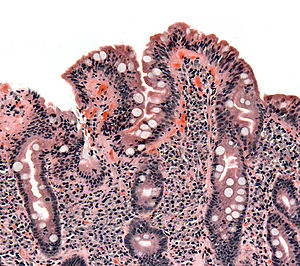Coeliac disease
| Coeliac disease | |
|---|---|
| Synonyms | celiac sprue, nontropical sprue, endemic sprue, gluten enteropathy |
 |
|
| Biopsy of small bowel showing coeliac disease manifested by blunting of villi, crypt hyperplasia, and lymphocyte infiltration of crypts | |
| Pronunciation | /ˈsiːli.æk/ |
| Classification and external resources | |
| Specialty | Gastroenterology |
| ICD-10 | K90.0 |
| ICD-9-CM | 579.0 |
| OMIM | 212750 |
| DiseasesDB | 2922 |
| MedlinePlus | 000233 |
| eMedicine | med/308 ped/2146 radio/652 |
| Patient UK | Coeliac disease |
| MeSH | D002446 |
| GeneReviews | |
Coeliac disease, also spelled celiac disease, is an autoimmune disorder affecting primarily the small intestine that occurs in people who are genetically predisposed. Classic symptoms include gastrointestinal problems such as chronic diarrhoea, abdominal distention, malabsorption, loss of appetite, and among children failure to grow normally. This often begins between six months and two years of age. Non-classic symptoms are the most common, especially in people older than two years. There may be mild or absent gastrointestinal symptoms, a wide number of symptoms involving any part of the body, or no obvious symptoms. Coeliac disease was first described in childhood; however, it may develop at any age. It is associated with other autoimmune diseases, such as diabetes mellitus type 1 and thyroiditis, among others.
Coeliac disease is caused by a reaction to gluten, which are various proteins found in wheat and in other grains such as barley, and rye. Moderate quantities of oats, free of contamination with other gluten-containing grains, are usually tolerated but problems may depend on the type consumed. Upon exposure to gluten, an abnormal immune response may lead to the production of several different autoantibodies that can affect a number of different organs. In the small-bowel this causes an inflammatory reaction and may produce shortening of the villi lining the small intestine (villous atrophy). This affects the absorption of nutrients, frequently leading to anaemia.
...
Wikipedia
